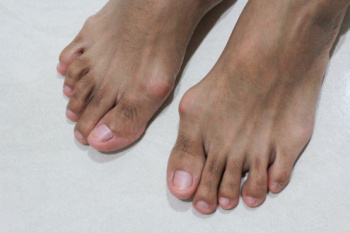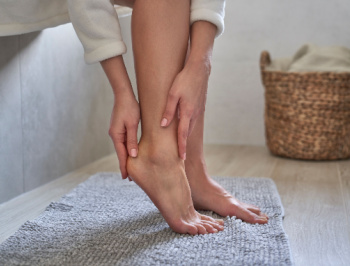Items filtered by date: February 2024
Diabetes-Related Foot Problems

Foot problems are a common complication of diabetes, primarily stemming from a loss of protective sensation, or LOPS, and peripheral artery disease, or PAD. The loss of feeling in the feet results from nerve damage, which can make a patient unaware of injuries. Undetected blisters or sores increase the risk of infections and complications, and may lead to ulcers. Regular foot examinations by a podiatrist are essential for a diabetic experiencing either LOPS or PAD. Prevention strategies include wearing well-fitting shoes, checking for foreign objects in shoes, and being cautious of extreme temperatures. It is important to note that peripheral artery disease decreases blood flow to the feet, which results in pain, slow wound healing, and an elevated risk of foot ulcers and amputation. A podiatrist can assess blood flow to the feet to detect PAD early, which allows for prompt management. If you are diabetic and experience numbness and slow-healing wounds, it is suggested that you make regular visits to a podiatrist.
Diabetic foot care is important in preventing foot ailments such as ulcers. If you are suffering from diabetes or have any other concerns about your feet, contact Shaun J. Limon, DPM and Lisa Griffith-Limon, DPM from Limons Foot & Ankle Care. Our doctors can provide the care you need to keep you pain-free and on your feet.
Diabetic Foot Care
Diabetes affects millions of people every year. The condition can damage blood vessels in many parts of the body, especially the feet. Because of this, taking care of your feet is essential if you have diabetes, and having a podiatrist help monitor your foot health is highly recommended.
The Importance of Caring for Your Feet
- Routinely inspect your feet for bruises or sores.
- Wear socks that fit your feet comfortably.
- Wear comfortable shoes that provide adequate support.
Patients with diabetes should have their doctor monitor their blood levels, as blood sugar levels play such a huge role in diabetic care. Monitoring these levels on a regular basis is highly advised.
It is always best to inform your healthcare professional of any concerns you may have regarding your feet, especially for diabetic patients. Early treatment and routine foot examinations are keys to maintaining proper health, especially because severe complications can arise if proper treatment is not applied.
If you have any questions please feel free to contact our office located in Lakewood Ranch, FL . We offer the newest diagnostic and treatment technologies for all your foot and ankle needs.
Methods That May Prevent Diabetic Limb Loss

One of the most concerning complications of diabetes is the risk of foot amputation. However, with proper management and proactive measures, many cases of foot amputation can be prevented entirely. A few significant ways to prevent amputation are effectively managing blood sugar levels, diligent foot care, and exercise. Adopting a healthy diet, performing daily foot inspections, and including regular exercise in your daily routine is essential for diabetic patients. Daily foot inspections can identify any abnormalities such as redness, wounds, bruising, blisters, or discoloration before they escalate into ulcers. For those with limited mobility or visibility, using a magnifying mirror or enlisting the help of a caregiver for foot checks is imperative. Regularly assessing foot sensation and temperature sensitivity is also vital in detecting neuropathy, a common complication of diabetes. Other simple measures such as wearing clean, dry socks without elastic bands, wiggling toes, and moving ankles frequently can improve blood circulation in the feet. Any signs of foot problems or neuropathy symptoms, such as numbness, burning, or tingling should be promptly reported to your podiatrist. It is suggested that diabetic individuals schedule regular visits with type of doctor for help in preventing the loss of a limb.
Diabetic Limb Salvage
Diabetic limb salvage can be an effective way in preventing the need for limb amputation. If you have a foot ulcer and diabetes, consult with Shaun J. Limon, DPM and Lisa Griffith-Limon, DPM from Limons Foot & Ankle Care. Our doctors will assess your condition and provide you with quality foot and ankle treatment.
What Is Diabetic Limb Salvage?
Diabetic limb salvage is the attempt of saving a limb, such as the foot, that has an infected ulcer, from amputation. Podiatrists also try to make sure that there is enough function in the foot after the salvage that it is still usable. Those with diabetes experience poor blood circulation, which prevents proper healing of an ulcer. If the ulcer is left uncheck, it could become infected, which could result in the need for amputation.
Diabetes is the number one cause of non-traumatic amputations in the United States. Amputation has been found to lead to higher mortality rates. This translates into higher healthcare costs, and a reduced quality of life and mobility for amputees. Podiatrists have attempted to increase the prevalence of limb salvage in an attempt to solve these issues.
Diagnosis and Treatment
Limb salvage teams have grown in recent years that utilize a number of different treatments to save the infected limb. This includes podiatrists that specialize in wound care, rehabilitation, orthotics, and surgery. Through a combination of these methods, limb salvage has been found to be an effective treatment for infected limbs, and as an alternative to amputation. Podiatrists will first evaluate the potential for limb salvage and determine if the limb can be saved or must be amputated.
If you have any questions, please feel free to contact our office located in Lakewood Ranch, FL . We offer the newest diagnostic and treatment technologies for all your foot care needs.
Recognizing Bunions as They Develop

Bunions, also known as hallux valgus, may be noticed as they form through various early signs. These signs encompass redness, swelling, thickened skin, and tenderness surrounding the big toe joint, often accompanied by a bony lump or prominence. Additionally, calluses and corns may develop due to increased pressure on the affected area. Early stages of bunion formation can cause discomfort, especially during activities such as walking or wearing tight shoes, and may lead to limited movement and stiffness in the big toe joint. As the bunion progresses, stiffness and decreased mobility of the big toe joint may occur. This can affect your ability to move the toe freely and may lead to further complications if left untreated. Recognizing these signs allows for proactive measures to slow the progression. If left untreated, bunions may lead to chronic pain, difficulty in walking, and other complications such as hammer toe deformities or arthritis of the big toe. Consultation with a podiatrist is suggested for a proper evaluation and treatment plan.
If you are suffering from bunion pain, contact Shaun J. Limon, DPM and Lisa Griffith-Limon, DPM of Limons Foot & Ankle Care. Our doctors can provide the care you need to keep you pain-free and on your feet.
What Is a Bunion?
Bunions are painful bony bumps that usually develop on the inside of the foot at the joint of the big toe. As the deformity increases over time, it may become painful to walk and wear shoes. Women are more likely to exacerbate existing bunions since they often wear tight, narrow shoes that shift their toes together. Bunion pain can be relieved by wearing wider shoes with enough room for the toes.
Causes
- Genetics – some people inherit feet that are more prone to bunion development
- Inflammatory Conditions - rheumatoid arthritis and polio may cause bunion development
Symptoms
- Redness and inflammation
- Pain and tenderness
- Callus or corns on the bump
- Restricted motion in the big toe
In order to diagnose your bunion, your podiatrist may ask about your medical history, symptoms, and general health. Your doctor might also order an x-ray to take a closer look at your feet. Nonsurgical treatment options include orthotics, padding, icing, changes in footwear, and medication. If nonsurgical treatments don’t alleviate your bunion pain, surgery may be necessary.
If you have any questions, please feel free to contact our office located in Lakewood Ranch, FL . We offer the newest diagnostic and treatment technologies for all your foot care needs.
The Important Role of Daily Foot Care

In the bustle of daily life, the significance of consistent foot care often escapes notice. The feet carry you through each day and deserve thoughtful care to maintain overall well-being. Practicing everyday foot care is not just a luxury, but a necessity. Regular inspection and cleansing can help to prevent issues such as fungal infections and calluses from escalating. Moisturizing keeps the skin supple and prevents painful cracks. Trimming nails properly helps evade ingrown toenails, a common source of discomfort. Choosing comfortable, supportive footwear is paramount in preventing long-term structural problems and pain. Additionally, incorporating simple exercises and stretches into daily routines enhances foot strength and flexibility. By prioritizing daily foot care, individuals invest in their mobility, comfort, and overall health. If you experience any type of foot pain, it is suggested that you consult a podiatrist who can conduct an exam and offer both a diagnosis and treatment.
Everyday foot care is very important to prevent infection and other foot ailments. If you need your feet checked, contact Shaun J. Limon, DPM and Lisa Griffith-Limon, DPM from Limons Foot & Ankle Care. Our doctors can provide the care you need to keep you pain-free and on your feet.
Everyday Foot Care
Often, people take care of their bodies, face and hair more so than they do for their feet. But the feet are a very important aspect of our bodies, and one that we should pay more attention to. Without our feet, we would not be able to perform most daily tasks.
It is best to check your feet regularly to make sure there are no new bruises or cuts that you may not have noticed before. For dry feet, moisturizer can easily be a remedy and can be applied as often as necessary to the affected areas. Wearing shoes that fit well can also help you maintain good foot health, as well as making it easier to walk and do daily activities without the stress or pain of ill-fitting shoes, high heels, or even flip flops. Wearing clean socks with closed shoes is important to ensure that sweat and bacteria do not accumulate within the shoe. Clean socks help to prevent Athlete’s foot, fungi problems, bad odors, and can absorb sweat.
If you have any questions please feel free to contact our office located in Lakewood Ranch, FL . We offer the newest diagnostic and treatment technologies for all your foot and ankle needs.


